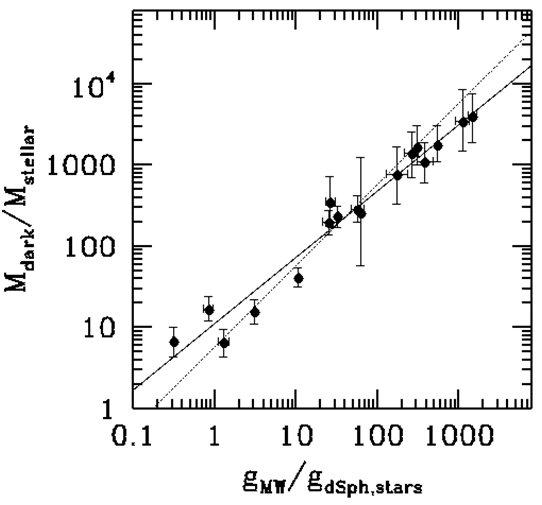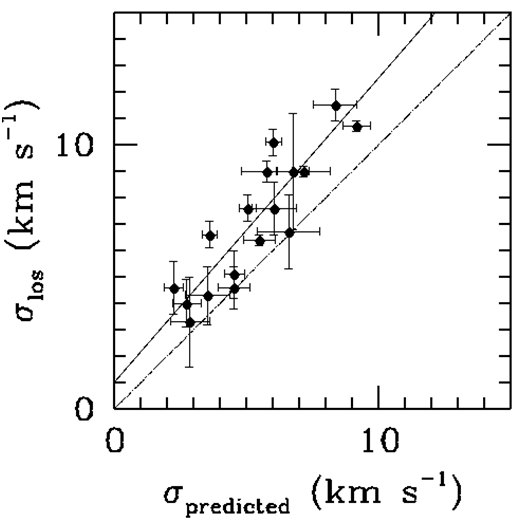Astronomers from Chinese-French international lab (LIA-ORIGINS) have refuted the formerly well-established proof of dark matter in dwarf galaxies. They demonstrate that star motions in dwarf galaxies that were believed to be governed by in-situ dark matter are indeed due to the gravitational forces of the Milky Way. This study appears in the Astrophysical Journal, June the 14th, 2018.
Since the 70s, astronomers have been convinced that dark matter is the main component of the matter in the Universe. The American astronomer Vera Rubin was the first to realize the need for dark –or invisible- matter to explain the high speed rotating gas at the edge of galactic disks. This had been verified by the Dutch astronomer, Albert Bosma, who confirmed the need of dark matter at much further distances from the disk, within the galactic haloes. Later on, in the 80s, the American astronomer Marc Aaronson discovered a similar effect, this time within the tiniest galaxies surrounding the Milky Way.
Since that time, several new dwarf galaxies have been discovered and motions of their stars have been studied. These have confirmed that stellar motions are too fast to be governed by the sole gravitational force due to the stellar or visible mass. Assuming dwarf galaxies being at equilibrium, cosmologists have explained the fast stellar motions by gravitational forces exerted by dark matter. They calculated that the smallest of them may contain thousand times more dark matter than visible matter. In such a frame, it was also assumed that the gravitational forces from the Milky Way are negligible.
An insufficiently explored alternative: the Milky Way gravitational force
The tiniest dwarf galaxies contain only few thousands of stars and are so faint that they cannot be observed elsewhere, farther than the halo of the Milky Way. By analysing their dynamical properties, a French-Chinese team of astronomers from the Paris Observatory - PSL, the National Astronomical Observatory of Chinese Academy of Sciences (NAOC), and the CNRS, has discovered an exceptionally strong relation between the assumed dark matter content in most dwarf galaxies, and the gravitational force due to the Milky Way. The relationship is so strong that the probability it is only due to a coincidental chance is smaller than one part over ten billion. This implies that the Milky Way gravitation does control the stellar motions in these dwarf galaxies, and conversely, that the in-situ dark matter does not. The team of astronomers has also shown that the correlation does not depend on the stellar mass. How can one explain such a result?
A new scenario
The Milky Way can indeed affect the stellar dynamics in dwarf galaxies through gravitational tides. The astronomers have shown that if these dwarf galaxies were encountering the Milky Way halo for the first time, they can be significantly driven out of equilibrium, and their stellar motions can be fully governed by the Milky Way gravitational forces, without any need for dark matter in dwarf galaxies. Such an alternative has been only rarely considered for dwarf galaxies populating the Milky Way halo. They were more generally considered as satellites orbiting around the Milky Way for several billion years. The alternative scenario is also supported by the fact that the two more massive dwarf galaxies in the Milky Way halo, the Magellanic Clouds, are indeed at their first passage.
This new scenario fully explains the exceptionally strong correlation between the supposed invisible mass in dwarf galaxies and the Milky Way gravitational acceleration or force. During the last billion years, several small galaxies that were rich in cold gas have approached the Milky Way environment. The Milky Way halo contains very hot gas at temperatures larger than one million degrees that has stripped the cold gas of dwarf galaxies, providing large instabilities in the motions of residual stars (see the movie). Then dwarf galaxies were out of equilibrium when they reached the Milky Way, which fully controlled motions of their stars. The astronomers have shown that by only knowing the dwarf galaxy distances to the Milky Way as well as their radii, one may predict accurately their stellar motions, which is measured by the velocity dispersion along the line of sight.
A change of paradigm for dark matter in dwarf galaxies
This study may affect most of our knowledge about the dark matter content in dwarf galaxies, since it could be extended to those in the neighbourhood of the Andromeda galaxy. "These results do not prove the absence of dark matter in dwarf galaxies, although there is no reason to further suppose its presence in absence of any proof", specifies Fran?ois Hammer, astronomer of the Paris Observatory - PSL, first author of the study. The team pursues studies to verify many predictions in particular in using the last results of the Gaia satellite.

Fig.1: The ordinate shows the supposed ratio of dark matter to stellar mass, which correlate very precisely with the ratio of the Milky Way gravitational acceleration to that caused by the stellar mass. Each of the 17 dwarf galaxies is represented by one point in this Figure. The full line shows the exceptionally strong correlation for dark matter to stellar mass ratios from 10 to 4000. The dotted line indicates the prediction based on the first passage scenario.

Fig.2: Stellar motions in dwarf galaxies are currently measured by the velocity dispersion of stars along the line of sight (slos). The abscissa provides the prediction from the first passage scenario (spredicted) that is very close to the measurements (slos, ordinate), which were done using high-resolution spectrographs. Lines have the same meaning as in the former Figure.
Credit: Observatoire de Paris - PSL/ Hammer et al. 2018.

Address: 20A Datun Road, Chaoyang District, Beijing, China code: 100012
Tel: 010-64888708 E-mail: naoc@nao.cas.cn

